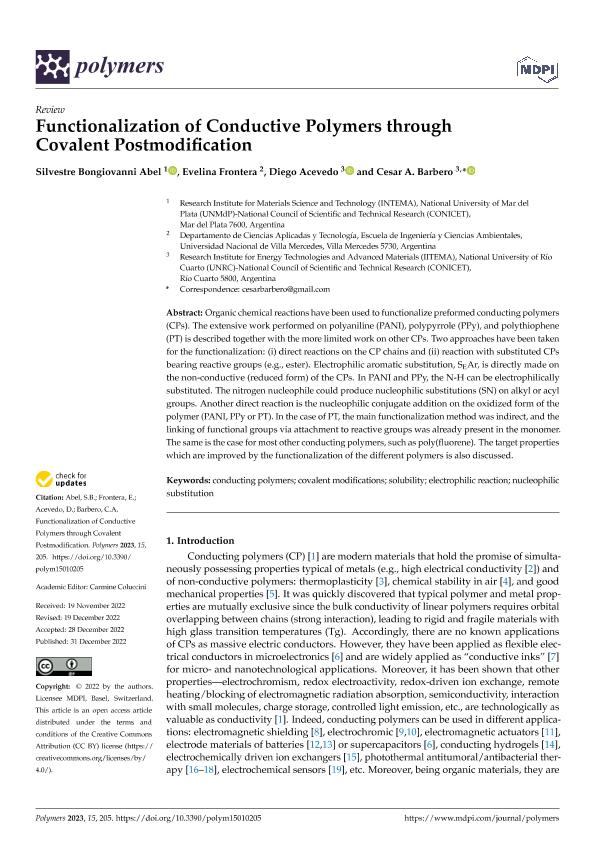Artículo
Functionalization of Conductive Polymers through Covalent Postmodification
Bongiovanni Abel, Silvestre Manuel ; Frontera, Evelina
; Frontera, Evelina ; Acevedo, Diego Fernando
; Acevedo, Diego Fernando ; Barbero, César Alfredo
; Barbero, César Alfredo
 ; Frontera, Evelina
; Frontera, Evelina ; Acevedo, Diego Fernando
; Acevedo, Diego Fernando ; Barbero, César Alfredo
; Barbero, César Alfredo
Fecha de publicación:
01/2023
Editorial:
MDPI
Revista:
Polymers
ISSN:
2073-4360
Idioma:
Inglés
Tipo de recurso:
Artículo publicado
Clasificación temática:
Resumen
Organic chemical reactions have been used to functionalize preformed conducting polymers (CPs). The extensive work performed on polyaniline (PANI), polypyrrole (PPy), and polythiophene (PT) is described together with the more limited work on other CPs. Two approaches have been taken for the functionalization: (i) direct reactions on the CP chains and (ii) reaction with substituted CPs bearing reactive groups (e.g., ester). Electrophilic aromatic substitution, SEAr, is directly made on the non-conductive (reduced form) of the CPs. In PANI and PPy, the N-H can be electrophilically substituted. The nitrogen nucleophile could produce nucleophilic substitutions (SN) on alkyl or acyl groups. Another direct reaction is the nucleophilic conjugate addition on the oxidized form of the polymer (PANI, PPy or PT). In the case of PT, the main functionalization method was indirect, and the linking of functional groups via attachment to reactive groups was already present in the monomer. The same is the case for most other conducting polymers, such as poly(fluorene). The target properties which are improved by the functionalization of the different polymers is also discussed.
Archivos asociados
Licencia
Identificadores
Colecciones
Articulos (IITEMA)
Articulos de INSTITUTO DE INVESTIGACIONES EN TECNOLOGIAS ENERGETICAS Y MATERIALES AVANZADOS
Articulos de INSTITUTO DE INVESTIGACIONES EN TECNOLOGIAS ENERGETICAS Y MATERIALES AVANZADOS
Articulos(INTEMA)
Articulos de INST.DE INV.EN CIENCIA Y TECNOL.MATERIALES (I)
Articulos de INST.DE INV.EN CIENCIA Y TECNOL.MATERIALES (I)
Citación
Bongiovanni Abel, Silvestre Manuel; Frontera, Evelina; Acevedo, Diego Fernando; Barbero, César Alfredo; Functionalization of Conductive Polymers through Covalent Postmodification; MDPI; Polymers; 15; 1; 1-2023; 1-45
Compartir
Altmétricas



